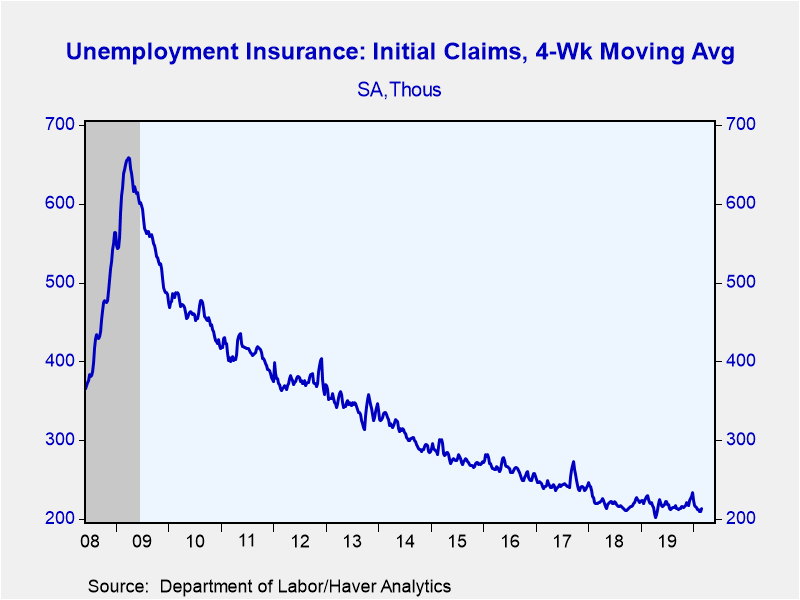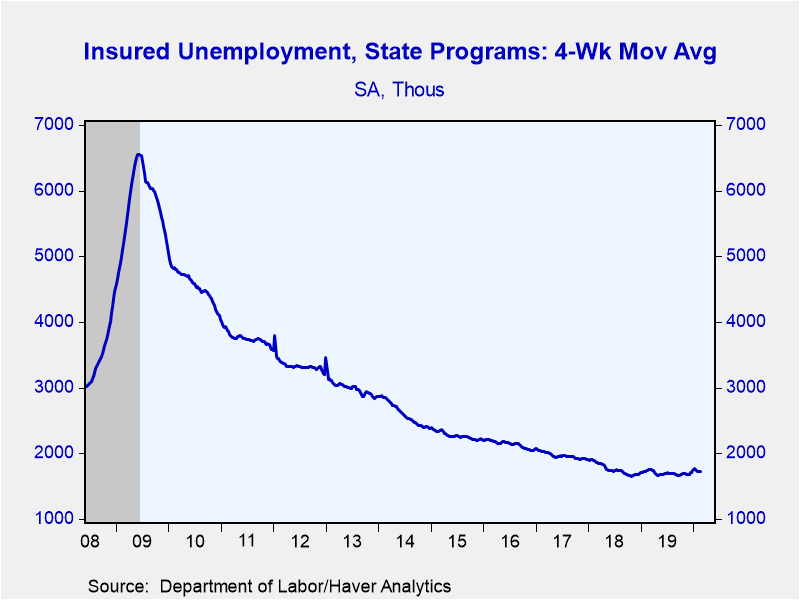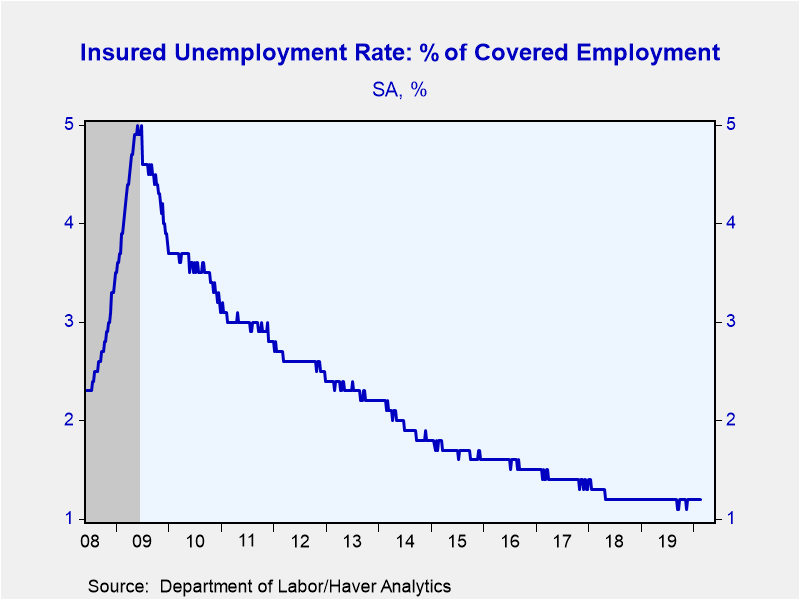 Global| Mar 05 2020
Global| Mar 05 2020U.S. Initial Unemployment Claims Fell Slightly
by:Sandy Batten
|in:Economy in Brief
Summary
Initial claims for unemployment insurance fell 3,000 to 216,000 (-0.9% y/y) in the week ended February 29 from an unrevised 219,000 in the prior week. The February 29 result was slightly lower than the Action Economics Forecast Survey [...]
Initial claims for unemployment insurance fell 3,000 to 216,000 (-0.9% y/y) in the week ended February 29 from an unrevised 219,000 in the prior week. The February 29 result was slightly lower than the Action Economics Forecast Survey at 220,000. The four-week moving average of initial claims was 213,000, up from 209,750 the previous week.
Continuing claims for unemployment insurance in the week ended February 22 rose to 1.729 million (-1.1% y/y) from a downwardly revised 1.722 million (initially 1.724 million) the previous week. The four-week moving average of claimants fell 7,500 to 1.721 million.
The insured rate of unemployment held steady at 1.2% in the week ended February 22, where it has been since mid-November. Except for a few weeks last fall when the rate dipped to 1.1%, it has been 1.2% since May 2018. The 1.1% rate was the lowest in the history of the series dating back to 1971.
Insured unemployment rates vary widely by state. The state data are not seasonally adjusted. During the week ended February 15, the lowest rates were in Florida (0.39%), North Carolina (0.49%), and Nebraska, New Hampshire and Virginia (0.60%). The highest rates were in Montana (2.49%), Connecticut (2.52%), West Virginia (2.59%), New Jersey (2.72%) and Alaska (2.88%). Among the other largest states by population, the rate was 1.04% in Texas, 1.74% in New York, 2.02% in California and 2.22% in Illinois.
Data on weekly unemployment claims dating back to 1967 are contained in Haver's WEEKLY database, and they are summarized monthly in USECON. Data for individual states are in REGIONW. The expectations figure is from the Action Economics Forecast Survey, carried in the AS1REPNA database.
| Unemployment Insurance (SA, 000s) | 02/29/20 | 02/22/20 | 02/15/20 | Y/Y % | 2019 | 2018 | 2017 |
|---|---|---|---|---|---|---|---|
| Initial Claims | 216 | 219 | 211 | -0.9 | 218 | 220 | 244 |
| Continuing Claims | -- | 1,729 | 1,722 | -1.1 | 1,701 | 1,756 | 1,961 |
| Insured Unemployment Rate (%) | -- | 1.2 | 1.2 |
1.2 |
1.2 | 1.2 | 1.4 |
Sandy Batten
AuthorMore in Author Profile »Sandy Batten has more than 30 years of experience analyzing industrial economies and financial markets and a wide range of experience across the financial services sector, government, and academia. Before joining Haver Analytics, Sandy was a Vice President and Senior Economist at Citibank; Senior Credit Market Analyst at CDC Investment Management, Managing Director at Bear Stearns, and Executive Director at JPMorgan. In 2008, Sandy was named the most accurate US forecaster by the National Association for Business Economics. He is a member of the New York Forecasters Club, NABE, and the American Economic Association. Prior to his time in the financial services sector, Sandy was a Research Officer at the Federal Reserve Bank of St. Louis, Senior Staff Economist on the President’s Council of Economic Advisors, Deputy Assistant Secretary for Economic Policy at the US Treasury, and Economist at the International Monetary Fund. Sandy has taught economics at St. Louis University, Denison University, and Muskingun College. He has published numerous peer-reviewed articles in a wide range of academic publications. He has a B.A. in economics from the University of Richmond and a M.A. and Ph.D. in economics from The Ohio State University.










